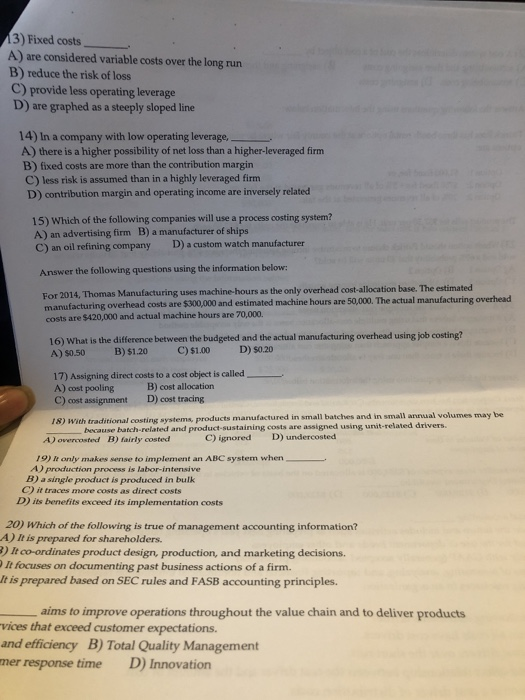3) Fixed costs B) reduce the risk of loss C) provide less operating leverage D) are graphed as a steeply sloped line 14) In a company with low operating leverage, A) there is a higher possibility of net loss than a higher-leveraged firm B) fixed costs are more than the contribution margin C) less risk is assumed than in a highly leveraged firm D) contribution margin and operating income are inversely related 15) Which of the following companies will use a process costing system? A) an advertising firm B) a manufacturer of ships C) an oil refining company D) a custom watch manufacturer Answer the following questions using the information below: For 2014, Thomas Manufacturing uses machine-hours as the only overhead cost-allocation base. The estimated manufacturing overhead costs are $300,000 and estimated machine hours are 50,000 The actual manufacturing overheacd costs are $420,000 and actual machine hours are 70,000. 16) What is the difference between the budgeted and the actual manufacturing overhead using job costing? A) s050 B)$1.20C)$1.00D) S0.20 17) Assigning direct costs to a cost object is called A) cost pooling C) cost assignment B) cost allocation D) cost tracing 8) With traditional costing systems, products manufactured in small batches and i because batch-related and product- sustaining costs are assigned using unit-related drivers A) overcosted B) fairly costed C) ignored D) undercosted 19) it only makes sense to implement an ABC system when A) production process is labor-intensive B) a single product is produced in bulk C) it traces more costs as direct costs D) its benefits exceed its implementation costs 20) Which of the following is true of management accounting information? 4) is prepared for shareholders. ) It co-ordinates product design, production, and marketing decisions. It focuses on documenting past business actions of a firm. It is prepared based on SEC rules and FASB accounting principles. aims to improve operations throughout the value chain and to deliver products vices that exceed customer expectations and efficiency B) Total Quality Management mer response time D) Innovation







